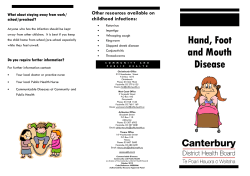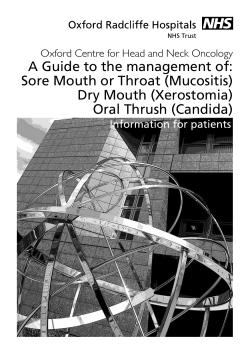
Hand, Foot and Mouth Disease Page 1 of 3
Page 1 of 3 Hand, Foot and Mouth Disease Hand, foot and mouth disease is usually a short mild illness that mainly affects children. Most children fully recover within a week. Serious complications occur rarely. This disease is NOT related to the disease with a similar name which affects animals. What is hand, foot and mouth disease and what causes it? Hand, foot and mouth disease (HFMD) is due to an infection that usually causes a typical illness, including a typical rash. It is most commonly caused by the Coxsackie A16 virus. Some cases are caused by a different, but related, virus called enterovirus 71. Rarely, the same illness is caused by other strains of the Coxsackie virus. What are the symptoms of hand, foot and mouth disease? HFMD most commonly affects children under 10 years of age. Older children and adults are sometimes affected. Adults and older children with HFMD tend to develop a milder form of the illness compared with younger children. Like many viral infections, the illness often starts with a feeling of being unwell for a day or so. This might include a high temperature (fever). After this a sore throat commonly occurs, quickly followed by small spots that develop inside the mouth. These soon progress into small mouth ulcers. In about 3 in 4 cases, spots also develop on the skin. This is typically a day or so after the mouth ulcers develop. The spots are small lumps that are a few millimetres in diameter and usually appear on the hands and feet. Spots sometimes also appear on the buttocks, legs and genitals. They rarely develop on other parts of the body. The spots are similar to chickenpox, but are smaller. Unlike chickenpox, they are not usually itchy but can be quite tender. For a list of websites that contain pictures of skin conditions including HFMD see www.patient.co.uk/showdoc/1097/ Is hand, foot and mouth disease serious? Usually not. The fever and spots usually clear within a few days. The mouth ulcers can be painful, and may last up to a week. The sore mouth may make a child miserable for a few days. In a very small number of cases, the virus affects the heart, lung or brain to cause a serious inflammation of the heart, lung or brain, which is fatal in some cases. But it has to be stressed - these serious complications are rare. What is the treatment for hand, foot and mouth disease? There is no treatment that will take away the virus. The aim is to ease symptoms and make your child as comfortable as possible until the illness goes away (which it normally does within a week or so). Page 2 of 3 Make your child comfortable A fever can make a child feel uncomfortable and irritable. The following are things that you can do that may bring the temperature down and make your child feel more comfortable: You can give paracetamol or ibuprofen. Both of these medicines can lower a temperature. You can buy these medicines in liquid form for children. They come in various brand names. An alternative is to give soluble paracetamol in a drink. The dose for each age is given with the medicine packet. Note: these medicines do not treat the cause of the fever. They merely help to ease discomfort. You do not need to use these medicines if the child is comfortable and not distressed by the fever. Note: do not give both paracetamol and ibuprofen at the same time. However, on occasions, if a fever is difficult to control then for each time a medicine dose is given, a doctor or nurse may advise alternating one of these medicines with the other. It is best only to do this alternating dose regime after assessment by a doctor or nurse. Note: do not use ibuprofen for: Children known to react (have hypersensitivity) to ibuprofen or other nonsteroidal anti-inflammatory drugs (NSAIDs). Children in whom attacks of asthma have been triggered by an NSAID. Take the clothes off the child if the room is normal room temperature. It is wrong to wrap up a feverish child. The aim is to prevent overheating or shivering. Give lots of to drink. This helps to prevent dehydration. You might find that a child is more willing to have a good drink if they are not so irritable. So, if they are not keen to drink, it may help to give some paracetamol or ibuprofen first. Then, try them with drinks half an hour or so later when their temperature is likely to have come down. Cool sloppy foods such as yoghurt may be best for a day or so if the mouth is sore. Ice lollies may help to ease a sore mouth, and are also a way of giving a drink. If breast-feeding then keep breast-feeding, as breastmilk is the best fluid. However, you can offer feeds more often to increase the amount of fluid. Do not cold-sponge a child who has a fever. This used to be popular, but it is now not advised. This is because the blood vessels under the skin become narrower (constrict) if the water is too cold. This reduces heat loss, and can trap heat in deeper parts of the body. The child may then get worse. Many children also find cold-sponging uncomfortable. Some people use a fan to cool a child. Again, this may not be a good idea if the fanned air is too cold. However, a gentle flow of air in a room which is room temperature may be helpful. Perhaps just open the window, or use a fan on the other side of the room to keep the air circulating. Tell a doctor if a child stops drinking due to a sore mouth as, rarely, dehydration may develop. Also, see a doctor promptly if you are concerned about any unusual symptoms that develop. Is hand, foot and mouth disease infectious? Yes. The incubation period is 3-5 days. This means it takes 3-5 days to develop symptoms after being infected from another person. Most cases are passed on by coughing and sneezing which transmits the virus into the air. It is mainly infectious until the spots and mouth ulcers have gone. Sometimes small outbreaks occur in nurseries and schools. However, children can still be mildly infectious for several weeks longer as the virus may be passed out with the faeces (stools) for several weeks after the symptoms have gone. Therefore, it is sensible to maintain good hygiene to reduce the chance of passing on the virus. For example: Page 3 of 3 Make sure that children wash their hands thoroughly after using the toilet. Aim to keep mouth and nose covered when coughing and sneezing. Wipe the nose and mouth with disposable tissues. Adults should take particular care when handling nappies and tissues. Wash hands thoroughly after handling nappies and tissues. Soiled clothes, bedding, and towels should be washed on a hot cycle of the washing machine. It is best not to share cups, eating utensils, towels, etc whilst ill with this infection and for several weeks afterwards. Do not deliberately pierce blisters, as the fluid is infectious. What about going to school? Guidance from the Health Protection Agency is that children should not routinely be kept from school if the have hand, foot and mouth disease if they are well enough in themselves to attend. Although there is a risk of passing it on to others, the illness is usually mild. References Frydenberg A, Starr M; Hand, foot and mouth disease. Aust Fam Physician. 2003 Aug;32(8):594-5. [abstract] Nervi S et al; Hand-Foot-and-Mouth Disease, Medscape, Oct 2009 Guidance on infection control in schools and other childcare settings, Health Protection Agency, April 2010 Comprehensive patient resources are available at www.patient.co.uk Disclaimer: This article is for information only and should not be used for the diagnosis or treatment of medical conditions. EMIS has used all reasonable care in compiling the information but make no warranty as to its accuracy. Consult a doctor or other health care professional for diagnosis and treatment of medical conditions. For details see our conditions. © EMIS 2011 Reviewed: 15 Apr 2010 DocID: 4260 Version: 41 For the planned review period see the Data Creation and Quality Control Process.
© Copyright 2025





















